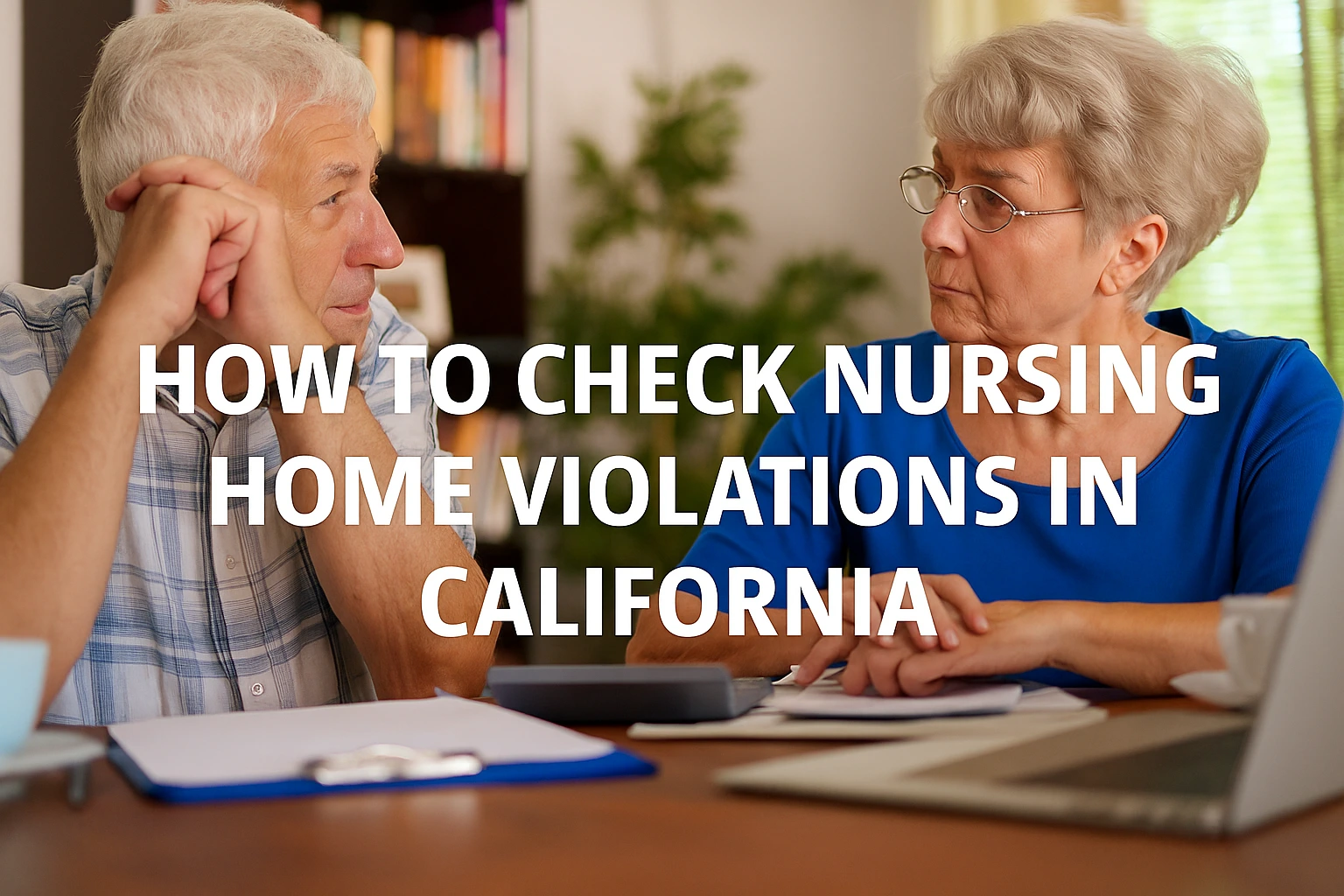How to Check Nursing Home Violations in California begins with the two official records systems that document inspections and enforcement. The process requires reading the Statement of Deficiencies and the Plan of Correction for each survey, then interpreting scope and severity levels and any Immediate Jeopardy findings. Current status is verified by confirming civil penalties, admission holds, payment denials, and the results of any revisit. When violations place a resident at risk, next steps include filing a complaint with the state regulator, contacting Adult Protective Services or law enforcement for urgent harm, and seeking a confidential consultation with Moran Law to secure evidence and pursue civil remedies.
Table of Contents
Access Official Violation Records For The Nursing Home
The most reliable method for how to check nursing home violations in California is to review the two official databases that publish inspection findings and enforcement actions, then compare the results. Begin with the state portal to see survey dates, statements of deficiencies, penalties, and any limits on new admissions. Open the federal portal next and read the health inspection history for the same facility.
In the state portal, open the facility profile and read each survey. Open the Statement of Deficiencies to see the facts, the regulation cited, the harm level, and the plan of correction. Confirm that the plan identifies the corrective action, the responsible role, the monitoring method, and the completion date. Check the enforcement section for civil penalties, admission holds, and whether a revisit recorded substantial compliance.
In the federal portal, open the health inspections for the same dates and confirm that deficiency tags and scope and severity levels align with the state record. Note any Immediate Jeopardy findings and whether the federal record shows the same corrective steps and verification of compliance. If the two records do not match, call the district office of the regulator or the county Ombudsman to confirm the current status.
Cal Health Find Facility Surveys, Citations, And Penalties
Cal Health Find is the California regulator’s record. Open the facility profile and review the survey history, then open each Statement of Deficiencies to see the cited regulation, facts found by state surveyors, harm level, and the plan of correction. Check the enforcement tab for civil penalties, admission holds, and any directed training, and confirm whether a revisit recorded compliance. Look for repeat citations across survey cycles and any Immediate Jeopardy findings to understand ongoing risk specific to the state record.
Medicare Care Compare Health Inspection Reports For The Facility
Medicare Care Compare is the federal lens on the same nursing home. Open the health inspections section to read standard and complaint surveys with federal tag numbers and the scope and severity grid. Note complaint counts, denial of payment for new admissions, civil money penalties, and any Special Focus Facility status. Compare dates and tags to the state record to confirm alignment. If you are teaching a family member how to check nursing home violations in California, show them how the federal file can reveal penalties or flags that expand on the state findings.
Read Nursing Home Inspection Documents
To see exactly why a facility was cited, read the survey documents themselves. This is central to How to Check Nursing Home Violations in California because it shows what inspectors observed, which regulation was violated, and whether the correction was verified. Start with the most recent survey for your facility, then review earlier surveys to see if the same problem appears again. Note the survey type, the unit involved, the dates, and any language that signals immediate risk to resident safety.
Statement Of Deficiencies Form 2567 For Your Facility
Form 2567 is the official record of the deficiency. It lists the regulation tag, the surveyor’s findings, and examples drawn from interviews, observations, and chart reviews. Focus on the conduct that breached the rule, how many residents were affected, and whether harm is described. Pay attention to timing details such as delays in calling a physician or in transferring to the hospital, since those facts often separate a paperwork issue from a serious care failure. If similar tags appear in earlier surveys, treat the issue as a continuing problem.
Plan Of Correction And Follow-Up Survey Results
The Plan of Correction should set specific actions, name who will do the work, describe how compliance will be monitored, and give a completion date. Compare those steps to the facts in the deficiency to judge whether the fix addresses the real cause. Then check the next survey to see if inspectors recorded substantial compliance. If a later survey cites the same tag, the correction was not effective and a new complaint may be warranted.
Evaluate the Seriousness of Violations at the Nursing Home
A core step in How to Check Nursing Home Violations in California is weighing how serious each deficiency is and whether the same problems keep returning. Start by reading the cited regulation and the inspector’s facts, then consider the harm described, the number of residents involved, and the speed of the facility’s response. Give extra attention to findings that show immediate danger, to tags that appear in several surveys, and to any enforcement that limited new admissions or required outside monitoring. Taken together, severity and repetition reveal whether a home corrected a one time lapse or is operating with ongoing risk to residents.
Scope and Severity Grid and Immediate Jeopardy Findings
The scope and severity grid assigns each deficiency a letter level from A through L that reflects two things, the extent of the problem and the harm or potential for harm. Read the narrative first, then match it to the letter level to understand whether the issue affected one resident or many and whether injury occurred. Immediate Jeopardy indicates an urgent threat to health or life. When that language appears, check what the inspector required, when the facility said the danger ended, and whether a revisit confirmed that residents were safe. High letter levels and Immediate Jeopardy deserve priority when deciding where to place a loved one or whether to keep a loved one in place.
Repeat Deficiencies and Incident Patterns
Repetition is evidence of system failure. Track the tag numbers, dates, and units involved across several surveys to see whether the same care rule keeps getting broken. Note whether the incidents cluster on certain shifts, involve the same service such as wound care or feeding assistance, or recur after the facility claimed to fix them. A pattern of repeat tags, even at lower letter levels, signals unresolved problems in training, staffing, or supervision and should guide your next steps, including complaint filing or a transfer plan.
Check Current Enforcement Status for the Nursing Home
After you locate citations, confirm whether regulators have active sanctions in place. This step is central to How to Check Nursing Home Violations in California because it shows if the home is still under restrictions and whether penalties were imposed. Open the state portal and the federal portal for the same facility and move to the enforcement sections. Note the date of each action, the legal basis for the action, and whether a revisit verified substantial compliance. Give priority to recent items and actions that restrict admissions or payments, since those signal ongoing risk to residents.
Civil Monetary Penalties, Admission Holds, and Monitoring Orders
Civil monetary penalties reflect the financial consequences of violations. In the federal record you may see per day penalties for ongoing noncompliance or per instance penalties for a specific event. The state record may show Class AA, Class A, or Class B citations with listed amounts. Compare penalty dates to the survey that triggered them and look for any reduction after informal dispute resolution. Admission holds and denial of payment for new admissions show that regulators limited new entries until the home corrected serious problems. Some facilities are placed under directed plans of correction, directed training, or temporary management. Each of these actions indicates that surveyors believed residents faced significant risk that required close oversight.
Compliance Confirmation and Removal of Sanctions
Sanctions do not end until regulators verify that the home corrected the underlying problems. In both the state and federal records, look for a revisit or follow up survey that documents substantial compliance and lists a verification date. Confirm that payment denials, admission holds, and monetary penalties were lifted or reduced only after that date. If the record shows pending appeals, treat the sanction as unresolved until there is a final entry. When enforcement remains active without a clear path to compliance, consider filing a new complaint or seeking help from the Ombudsman to prompt a status check.
Take Action When Violations Affect a Resident
Finding citations is only the start. When a violation threatens a resident’s safety, move from review to action. If danger is immediate, call emergency services first. For ongoing concerns, document what you observed, the date and time, the unit or room, and the response from staff. Use this record to file a formal complaint and to guide any follow up conversations. This is the practical end point of How to Check Nursing Home Violations in California because it connects inspection findings to real protection for the person in care.
File a Complaint with the State Regulator
Submit a written complaint to the state health regulator and request a complaint number. Provide the facility name and address, the resident’s status, the dates and times, and a concise factual account of what occurred. Attach copies of items you may lawfully keep, such as prior care notes or photographs. Ask for an unannounced investigation, and state if you fear retaliation so the investigator plans safe contact. Keep a log of every call and letter, and follow up if you do not receive confirmation that an investigation has begun.
Contact Adult Protective Services or Law Enforcement
Adult Protective Services investigates abuse and neglect of elders and dependent adults and can coordinate with the state regulator. Report when you see harm, a credible threat of harm, or a pattern of care failures the facility fails to correct. If you believe a crime occurred, such as assault or financial exploitation, notify local law enforcement after you have ensured the resident’s immediate safety. Tell each agency that a state complaint has been filed so they can align their work.
Request a Confidential Legal Consultation with Moran Law
Nursing Home Neglect Lawyers can protect the resident and the evidence while agencies conduct their reviews. Moran Law has resolved numerous nursing home abuse matters, including results of 1,650,000 dollars in a pressure ulcer sepsis case, 1,500,000 dollars in a respiratory support failure case, 1,000,000 dollars in an aspiration pneumonia case, 2,000,000 dollars in a C diff matter that progressed to sepsis, and multiple fall cases that involved brain injuries and death. During a confidential consultation, the firm evaluates liability, secures records, and advises on safe next steps while coordinating with investigators. Early involvement helps preserve proof and prevents further harm.


